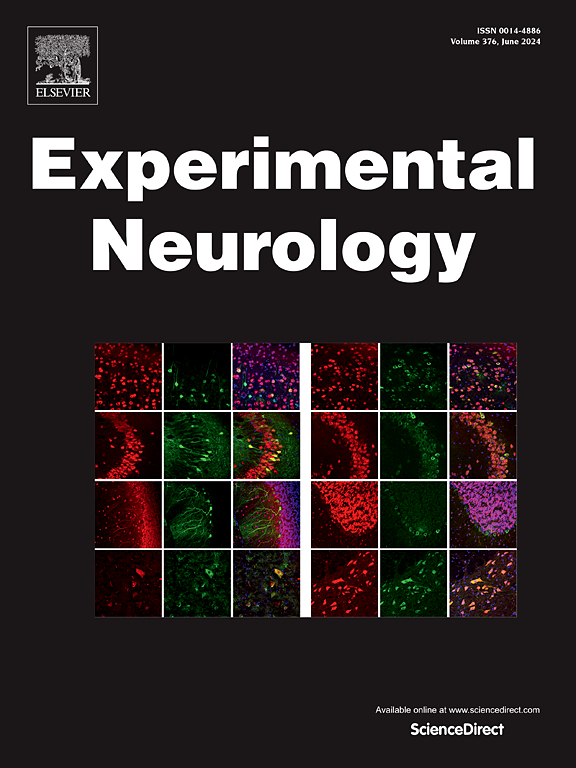高胆固醇血症导致小胶质细胞功能障碍,并减弱对淀粉样斑块的反应
IF 4.6
2区 医学
Q1 NEUROSCIENCES
引用次数: 0
摘要
高胆固醇血症是公认的阿尔茨海默病(AD)的合并症,但其与AD病理的机制联系,特别是其对小胶质细胞功能和β淀粉样蛋白(a β)动力学的影响尚不清楚。为了研究这一点,我们使用了APPNL-G-F (AK)小鼠模型,该模型具有强大的a β病理,以及APPNL-G-F;LDLR - / - (ALKO)模型,该模型将a β病理与LDL受体缺乏相结合,以诱导西方饮食(WD)下的高胆固醇血症。这些模型旨在研究遗传易感性和饮食因素对阿尔茨海默病进展的联合影响。在6个月大的时候,小鼠保持控制饮食或切换到WD两个月,以诱导高胆固醇血症。我们的研究结果表明,高胆固醇血症抑制了小胶质细胞对Aβ斑块的反应,证明了斑块周围小胶质细胞聚集和激活的减少。WD和LDLR缺乏症联合作用降低了疾病相关小胶质细胞标志物的表达,导致Aβ斑块致密性降低。在机制上,RNA测序显示高胆固醇血症损害了小胶质细胞线粒体功能,减少了蛋白质合成,并加剧了神经炎症。脂质组学分析揭示了小胶质细胞脂质组的显著变化,包括神经酰胺、己糖神经酰胺和溶血磷脂酰胆碱升高,以及n -酰基乙醇胺减少,反映了促炎和代谢应激的小胶质细胞状态。行为学分析进一步显示,WD和LDLR缺乏症单独和协同地损害AD小鼠的认知表现和增加焦虑样行为。总之,本研究强调了高胆固醇血症通过破坏小胶质细胞功能、改变脂质代谢和损害认知功能而加剧AD病理的作用,并提示高胆固醇血症的药物管理可以减缓AD的进展。本文章由计算机程序翻译,如有差异,请以英文原文为准。
Hypercholesterolemia drives microglial dysfunction and weakens response to amyloid plaques
Hypercholesterolemia is a recognized comorbidity of Alzheimer's disease (AD), yet its mechanistic connection to AD pathology, particularly its impact on microglial function and amyloid-beta (Aβ) dynamics remains unclear. To investigate this, we utilized the APPNL-G-F (AK) mouse model, which develops robust Aβ pathology, and the APPNL-G-F;LDLR−/− (ALKO) model, which combines Aβ pathology with LDL receptor deficiency to induce hypercholesterolemia under a Western diet (WD). These models were designed to study the combined effects of genetic predisposition and dietary factors on AD progression. At six months of age, mice were maintained on a control diet or switched to a WD for two months to induce hypercholesterolemia. Our findings demonstrate that hypercholesterolemia suppresses microglial responses to Aβ plaques, evidenced by reduced clustering and activation of microglia around plaques. The combination of WD and LDLR deficiency synergistically diminished the expression of disease-associated microglia markers, resulting in reduced Aβ plaque compactness. Mechanistically, RNA sequencing revealed hypercholesterolemia impaired microglial mitochondrial function, reduced protein synthesis, and heightened neuroinflammation. Lipidomic profiling revealed significant changes in the microglial lipidome, including elevated ceramides, hexosylceramides, and lysophosphatidylcholine, along with reduced N-acylethanolamines, reflecting a pro-inflammatory and metabolically stressed microglial state. Behavioral analyses further revealed that both WD and LDLR deficiency independently and synergistically impaired cognitive performance and increased anxiety-like behaviors in AD mice. Together, this study highlights the role of hypercholesterolemia in exacerbating AD pathology by disrupting microglial function, altering lipid metabolism, and impairing cognitive function, and suggests that pharmacological management of hypercholesterolemia could slow AD progression.
求助全文
通过发布文献求助,成功后即可免费获取论文全文。
去求助
来源期刊

Experimental Neurology
医学-神经科学
CiteScore
10.10
自引率
3.80%
发文量
258
审稿时长
42 days
期刊介绍:
Experimental Neurology, a Journal of Neuroscience Research, publishes original research in neuroscience with a particular emphasis on novel findings in neural development, regeneration, plasticity and transplantation. The journal has focused on research concerning basic mechanisms underlying neurological disorders.
 求助内容:
求助内容: 应助结果提醒方式:
应助结果提醒方式:


